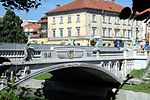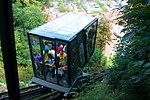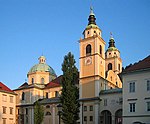Ljubljana Central Market
1942 establishments in Yugoslavia20th-century architecture in SloveniaBuildings and structures in LjubljanaCommercial buildings completed in 1942Economy of Ljubljana ... and 4 more
Jože Plečnik buildingsRetail markets in SloveniaVodnik SquareWorld Heritage Sites in Slovenia
The Ljubljana Central Market (Slovene: Osrednja ljubljanska tržnica) is a market in Ljubljana, Slovenia. The riverside market building, sometimes referred to as Plečnik's Market (Slovene: Plečnikova tržnica), was designed by Jože Plečnik between 1931 and 1939. It stretches between the Triple Bridge and the Dragon Bridge, on the right bank of the Ljubljanica River. The marketplace and Vodnik Square (Slovene: Vodnikov trg), where it is located, are cultural monuments of national significance. It is partly located at Adamič and Lunder Embankment (Adamič-Lundrovo nabrežje) and at Pogačar Square (Pogačarjev trg).
Excerpt from the Wikipedia article Ljubljana Central Market (License: CC BY-SA 3.0, Authors).Ljubljana Central Market
Adamič-Lundrovo nabrežje, Ljubljana Trnovo
Geographical coordinates (GPS) Address Nearby Places Show on map
Geographical coordinates (GPS)
| Latitude | Longitude |
|---|---|
| N 46.051666666667 ° | E 14.509722222222 ° |
Address
Adamič-Lundrovo nabrežje 5
1104 Ljubljana, Trnovo
Slovenia
Open on Google Maps









